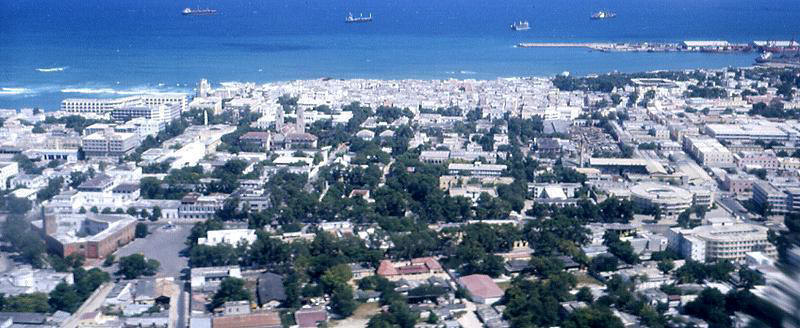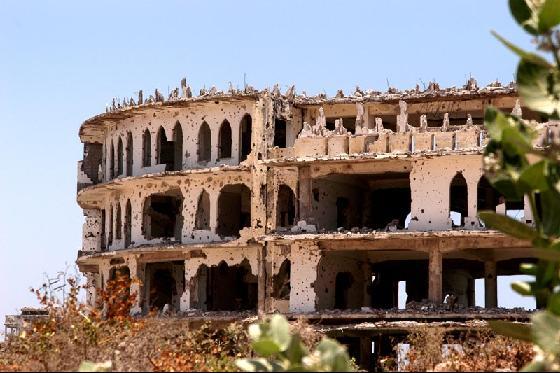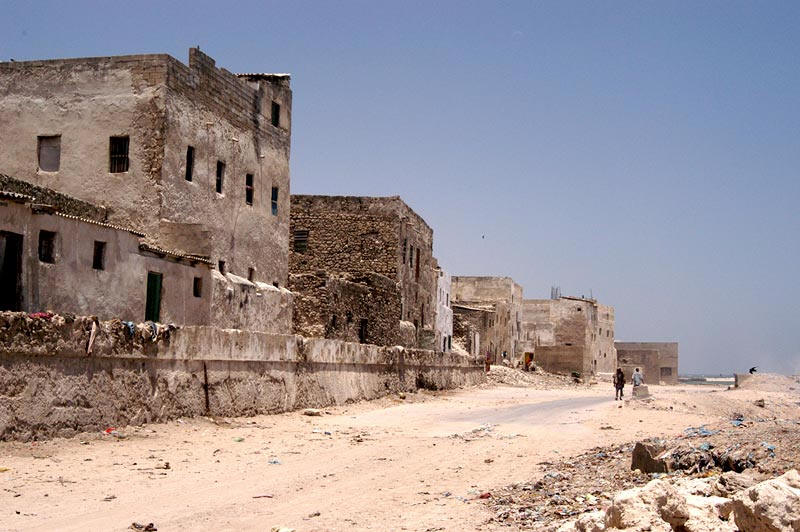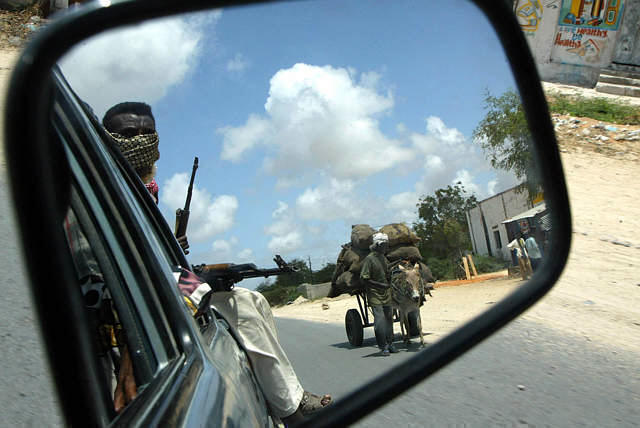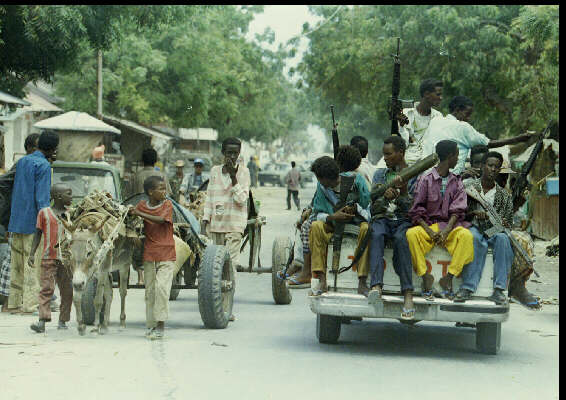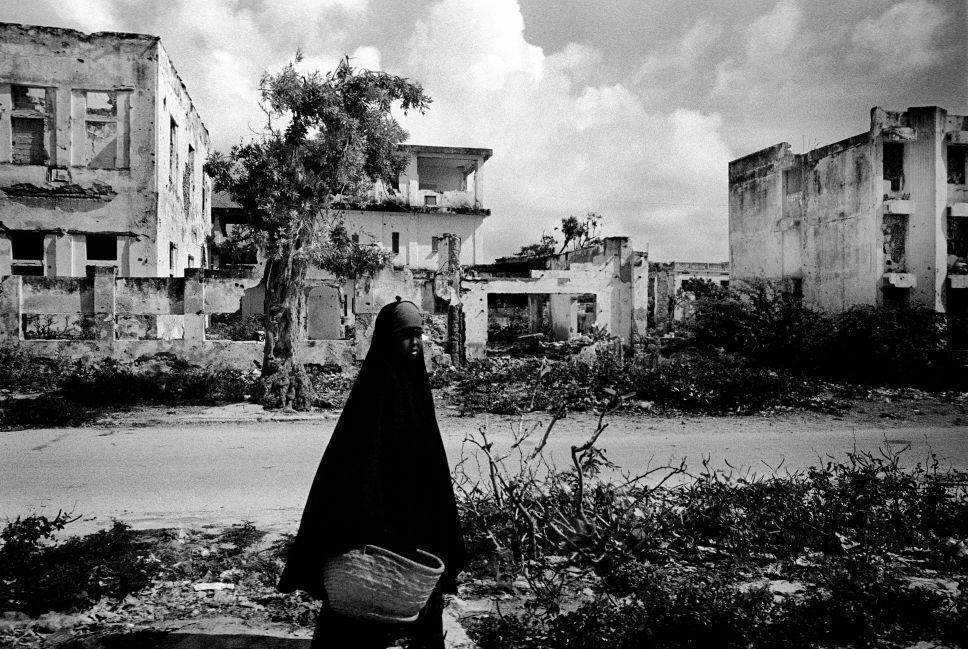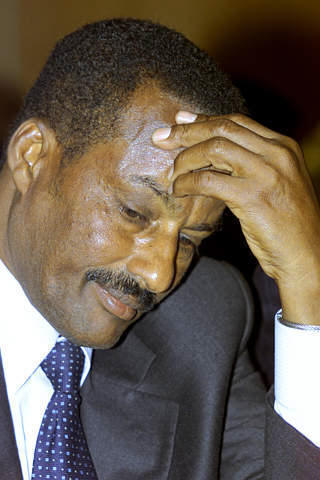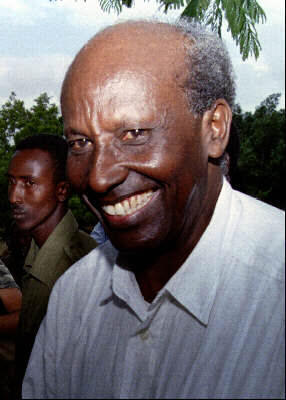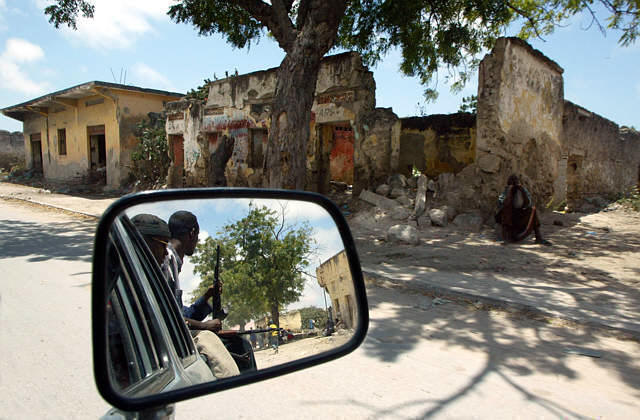Retreat From Somalia Lives
were saved, but opportunities for peace were
lost during the United Nations' mission
Robert M. Press
The Christian Science Monitor
February 27, 1995
WHEN Gunnery Sgt. Franklin Reid of Richmond,
Texas, landed on the dune-lined beach here
in December 1992 to protect food convoys to
starving Somalis, he was amazed.
In full battle gear, he looked around and
found no enemies -- only smiling and waving
Somalis, including many children. "I've been
in quite a few landings," he said that day.
"I've never seen one like this."
Now, 27 months later, some 7,000 United
States troops have returned to Somalia's
coastal waters to protect the exit of the
last Pakistani and Bangladeshi United
Nations peacekeeping troops from the
country.
But instead of friendly faces lining the
beaches, heavily armed vehicles ("technicals")
and their machine-gun crews wait outside the
port and airport to seize every bit of
property the departing troops abandon.
The scene underlines the inconclusive nature
of the UN's Somalia mission. While thousands
of Somali lives were saved from famine and
war by the troops' early efforts, the
attempt to stabilize the country and find a
political solution failed. That failure
occurred, say many Somali and Western
observers on the scene, for at least three
reasons: The mission never shifted from a
military effort to a genuinely political
one; the attempt at political negotiations
was not built on knowledge of Somali
traditions; and the military mission took a
turn that undermined its peacekeeping role.
In fact, many of the resources spent on the
mission bolstered the power of the very
warlord most responsible for harassing and
obstructing the UN in Somalia.
Those poised to move into UN-evacuated areas
are mostly supporters of Gen. Mohamed Farah
Aideed. General Aideed never liked the idea
of a UN military intervention. Yet the UN
located its headquarters in south Mogadishu,
the area of the capital he controls, and it
was largely his supporters who were paid
rent, received many UN contracts and jobs --
and, almost certainly in some instances,
spied on the UN for their leader.
Money spent by the UN in Aideed's territory
fueled the conflict by providing his side
with money for arms to fight rival Ali Mahdi
Mohamed, according to Fred Cuny, a
consultant on Somalia for the United States
Agency for International Development (USAID),
and Andrew Natsios, President Bush's relief
coordinator for Somalia.
Now those Somalis employed by the UN will be
jobless and, Somali analysts say, more
likely to fight other clans to get what they
need to support their families.
"I expect new inter-clan conflict; the port
and the airport are big assets which will
help whoever takes them," says Ahmed Warfa,
a former UN official in Somalia. Somalia may
fall back into the anarchy and hunger of
pre-December 1992 "or worse," says A. H.
Osman, a Somali medical technician with
contacts in various factions. "The gunmen
can still do what they want."
Aideed rival Ali Mahdi and his supporters --
who control north Mogadishu and who were
more friendly to the UN -- resent the fact
that the UN set up shop near Aideed, yet
never disarmed him and failed to bring about
peace.
The UN spent some $1.7 billion on the
Somalia operation, mostly to support and
guard itself. The US paid another $1.8
billion between April 1992 and July 1994,
State Department figures show.
"We don't know where the money has gone,"
says Abdi Dubaay Madoobe, a local chief in
Saco Uen, a central Somalia town. He says
he's glad to see the UN go.
What was learned
The overriding lesson emerging from Somalia,
according to many UN and US officials,
Somali analysts, and others interviewed is
this:Foreign troops can be a help getting
relief food through in emergencies, but they
cannot obtain a political settlement --
especially in a country where anarchy
reigns.
"We've been able to save a lot of people
from hunger and disease, but not been able
to contribute anything politically," Brig.
Gen. Saulat Abbas, commander of the
Pakistani troops in Somalia, told the
Monitor earlier this month.
Estimates vary on the number of lives saved.
The world was slow to respond to Somalia's
crisis, which began after dictator Mohamed
Siad Barre was overthrown in January 1991.
As the fighting over who would replace him
intensified, Somalis fled their farms for
towns, many of which lacked supplies to feed
them.
Many lives saved
Between early 1991 and mid-1993, an
estimated 250,000 to 300,000 Somalis died
from the fighting or famine, according to UN
and US estimates. At least 154,000 of those
lives could have been saved if the West had
acted sooner, said the Refugee Policy Group
(RPG) in Washington, D.C., in a November
report completed for the US Agency for
International Development (USAID).
Once the West and the UN swung into action
with a relief airlift in August-December
1992, some 100,000 to 125,000 lives were
saved, the report says. The RPG estimates
that the military intervention in December
1992 saved 10,000 to 25,000 lives.
But a political solution has eluded the UN.
Senior UN officials blame the Somalis. "One
of the messages for all of us around the
world is that the international community
does not have unlimited resources, and
there's a limit to its patience," says Kofi
Annan, the UN's senior peacekeeping
official.
But many analysts contend the UN could have
done more to achieve a reconciliation.
"I think {the UN mission} delayed a healing
process" among leaders of rival factions,
says UN consultant Gilles Stockton, a
Montana rancher who was a Peace Corps
volunteer in Somalia in the 1960s. "Somalia
was like a big jigsaw puzzle with 2,000
pieces," Mr. Stockton says. The UN "tried to
look at it as a puzzle with two pieces."
Instead of focusing primarily on the two
"warlords," Ali Mahdi and General Aideed,
the UN should have worked more with other
traditional leaders, businessmen, and
intellectuals in various parts of the
country, Stockton explains.
In the self-proclaimed independent territory
of Somaliland in northwest Somalia, four
months of negotiations in 1993 by
traditional leaders (without UN involvement)
resulted in a peace pact among various
factions. That could be a "grass-roots
model" for peace in the rest of Somalia,
says Jama Mohamed Omar, a former Somali
diplomat from the area.
UN focus questioned
In January 1993, US military spokesman Col.
Fred Peck told reporters that Somalia would
be stable by the end of the month. But US
and UN troops ran into a lot of trouble,
especially after the June 5 ambush killing
of 24 Pakistani soldiers. The UN immediately
passed a resolution directing its troops to
go after the culprits. Senior UN officials
named Aideed as the mastermind, which he
denied.
With 90,000 UN peacekeepers around the
world, Mr. Annan says, the UN could not "let
that {attack} go unchecked." One US official
at the time said it was inevitable that
Aideed would attack the UN, because he had
opposed UN military intervention from the
start.
Annan, the undersecretary-general for UN
peacekeeping operations, said the hunt-Aideed
campaign from June to October 1993 "got out
of hand."
On July 12, 1993, UN forces bombed without
warning what they thought was an Aideed
command post, killing Aideed supporters and
others, including some elders; Aideed was
not among them. Altogether, 20 or 70 people
were killed, depending on whether one uses
the UN estimate or Aideed's count.
On several occasions, elite US Rangers
searching for Aideed landed by mistake on
the roofs of Western relief agencies,
raising serious questions about intelligence
capabilities. They did snag Aideed aides in
other raids, releasing them months later.
The mistake, many analysts say, was that
instead of going after Aideed's militia, the
UN went after Aideed himself. The UN was no
longer seen as a neutral force, Annan and
other analysts say.
"So the lesson on impartiality and
neutrality was affirmed," Annan told
reporters earlier this month in Nairobi,
Kenya.
On Oct. 3, 1993, Aideed's forces killed 18
US Rangers; at least 200 Somalis were
reported killed in the battle. In the US,
horrified television viewers saw one of the
dead US soldiers dragged through the streets
of the capital.
Four days later, President Clinton announced
that he was ordering US troops out of
Somalia by March 31, 1994.
A US military official told this reporter at
the time: "The lesson coming out of Somalia
is: 'It got too hard, and we're going
home."'
Infighting over farmland
Critics charge the UN recruited few real
experts on Somalia, did not effectively use
the ones they had, and underutilized help
available from Somali intellectuals.
And the UN missed a key issue: the
inter-clan wars under way during 1993-94 --
and still not settled -- over farmland in
southern and central Somalia. These wars are
the result of a century-old movement of
major Somali clans south from nomadic
grazing areas that have become
overpopulated, says Ken Menkhaus, a former
UN official in Somalia.
Bantu and other local residents have been
shoved off their lands by armed militias
moving south, says John Prendergast of the
Center of Concern, a private group in
Washington focusing on Africa.
With UN help, those militias could have been
demobilized to farm and do other work, he
says.
UN weaknesses, critics say, were compounded
by internal corruption. Some UN assets were
stolen by its own forces, according to UN
and US officials.
"Egyptians were selling vehicles {at the
port}; Nigerian forces were selling passes
into the {now-looted UN} compound;
Pakistanis were caught leaving {Somalia}
with crates of 'military equipment' that
turned out to be full of UN air conditioners
and appliances," Mr. Menkhaus charged last
year.
"It's absolute corruption; it's awful," says
one US diplomat.
The UN mission was also costly in terms of
lives. Altogether, 135 troops have been
killed in the UN operation. The Pakistanis,
who suffered the worst casualties (33) "were
the first to come {to Somalia} and will be
the last to go," General Abbas says.
Signs of progress
Despite the precarious situation in
Mogadishu as troops pull out, there are
signs of progress in several parts of the
country.
"Somalia is not the black hole a lot of
Americans think it is," says Christine Hjelt,
an official with USAID. Rudimentary,
poorly-equipped schools have reopened in
many places, sometimes with funds from
relief agencies or the UN.
Last August and September, farmers had a
good harvest, and they appear to be bringing
in another one now, giving them a cushion
for one to two years in case of drought, Ms.
Hjelt says.
In the area between the Juba and Shabelle
Rivers in central and southern Somalia, many
farmers are back home after fleeing earlier
violence. In Baidoa, more than 100 farmers
gathered late last year for a workshop on
better farming methods organized by local
leaders, Hjelt adds. "Very little food is
given away right now," she says.
The UN World Food Program provides food to
unpaid teachers, and for development work.
In northern Somalia, livestock exports have
reached the pre-civil-war levels of the
1980s, says Gilles Stockton, who just
completed a livestock survey for the UN.
Somalia's economy depends largely on exports
of bananas and livestock, particularly to
the Gulf States. Some of Somalia's northern
ports are very active now. Somaliland is
using import duties to help run its
fledgling government, says Mr. Omar. "Life
there {in Somaliland} is coming up."
Of approximately 58 district councils (local
governments) formed with the encouragement
of the UN, about 45 are still functioning to
some degree, says Ahmed Warfa, who helped
the UN supervise their creation. He says it
was "a Somali process" rather than a direct
UN effort that brought them into being.
Today they are struggling financially,
however, and may not survive without greater
regional taxation or outside assistance.
Continuing tensions
Even in divided Mogadishu, changes have
occurred. By some assessments, Aideed has
lost some power because of factional splits
in his ethnic group, the Habar-Gedir, a
sub-clan of the Hawiye. Ali Mahdi has also
seen splits develop among his sub-clan, the
Abgal.
"Things are changing here," says Halima
Ismail, who helps run a cooperative for
women that teaches them handicrafts,
computer skills, and other ways to make
money. "People are asking: 'Why are we
fighting?"'
With the Ali Mahdi and Aideed factions
weakened, and with some pro-peace pressure
developing on both sides, any renewed
fighting may be less intense.
Yet splits can heal quickly if new
inter-clan fighting breaks out. "Somalis
love their clan more than religion," says
one Somali analyst.
Wars over land in the central Somalia
farming regions are "possible" says Abdul
Khaliq Ali, a Somali businessman from the
north. And Kismayu, a major southern port
city, is "smoking from the bottom" with
political tensions, he adds. Formation of a
central government is unlikely for years,
Ali adds. "We learned from {former dictator
Gen. Mohamed} Siad Barre that the clan in
power will grab all the power. No clan will
trust another clan for some time."
After the troops leave
As the last UN troops pack up, many Somalis
"feel like the world is abandoning them,"
says Nancy Smith of the British charity
Oxfam.
But most UN agencies and private relief
groups intend to stay, although they have
withdrawn staff from Mogadishu temporarily
until things settle down again.
CARE, like many agencies in Somalia, shifted
to development work after the famine. It is
now training health workers, restoring water
catchment areas near Baidoa, and supervising
agricultural and other work by various
agencies under USAID funding, says CARE's
Bob Laprade. The UN troop pullout will have
little immediate effect on many parts of
Somalia, he says, "because they {the UN}
have not really had a presence ever in most
of the country."
Mrs. Ismail predicts more fighting, but says
the UN pullout may actually help Somalia.
"Now we realize there's no more
international rescue ahead," she says, from
a veranda in a neighborhood that has seen
fierce street fighting in recent weeks."So
if they {UN troops} go," she says, "maybe
we'll get our own solution."
PHOTOS: (Page One) US and Italian Marines
Prepare for Pullout at Mogadishu Airport:
The United Nations' two-year mission to
Somalia saved thousands from famine, but
could not rescue the nation from anarchy. A
US-led group will guard the withdrawal of
the last peacekeeping forces this week.,
CORINNE DUFKA/REUTERS 1) HEADED HOME:
Pakistani soldiers board a plane in
Mogadishu Feb. 13. Pakistanis bore the brunt
of the casualties among UN troops. They were
the first to arrive, last to leave., CORINNE
DUFKA/REUTERS 2) SOMALIA, 1993: A United
States soldier, part of Operation Restore
Hope, patrols a Somalian street. At the
peak, there were 26,000 US military
personnel there., BETTY PRESS/WOODFIN CAMP &
ASSOCIATES/FILE 3) UNICEF FEEDING CENTER,
1992: Miriam Mohamed, a Somali nurse,
returned from her studies in India to help
her country shortly after dictator Mohamed
Siad Barre was deposed in January 1991. The
international famine-relief effort saved an
estimated 100,000 to 125,000 people., BETTY
PRESS/WOODFIN CAMP & ASSOCIATES/FILE 4) GEN.
Mohamed Farah Aideed: The Somali warlord
opposed UN military action in his country
from the start, but was strengthened by its
presence., HOS MAINA/REUTERS/FILE; MAP:
Showing Somalia, KAREN NORRIS SCHNEIDER,
STAFF.
� 1995 Christian Science Monitor.
